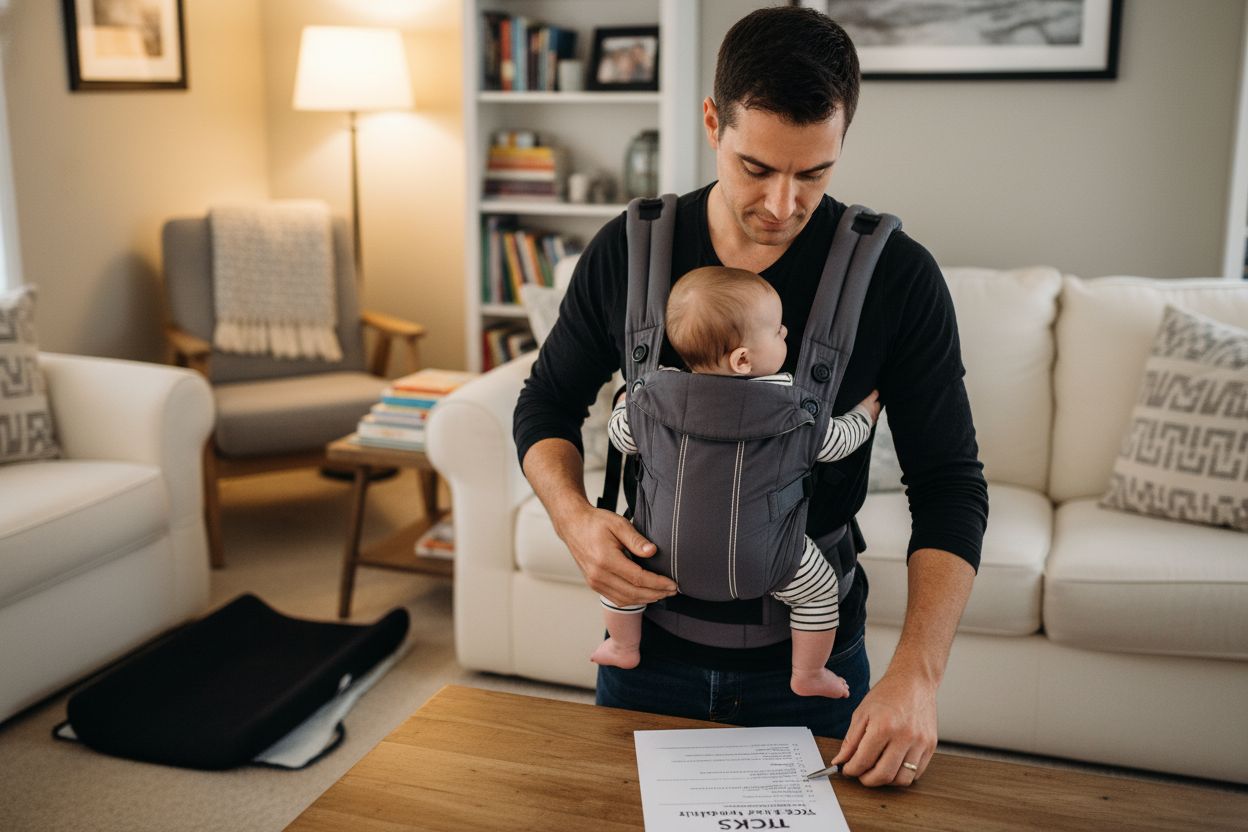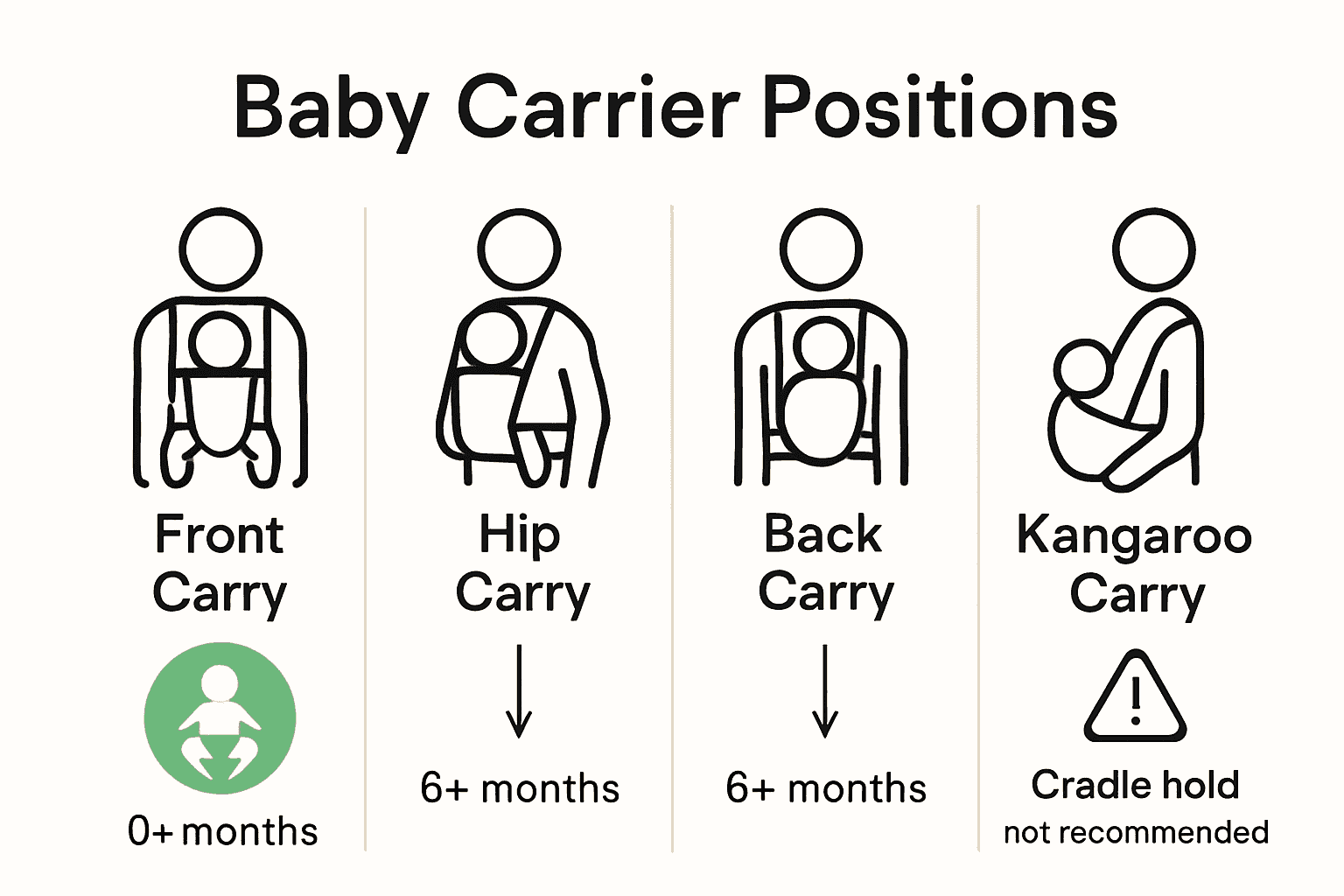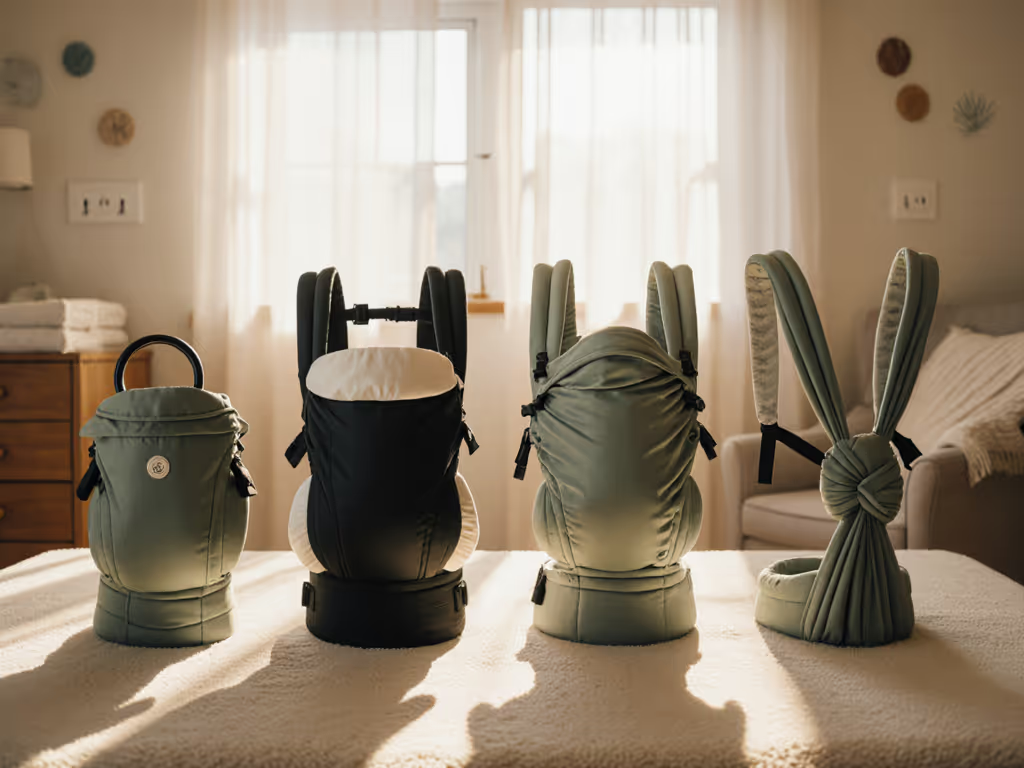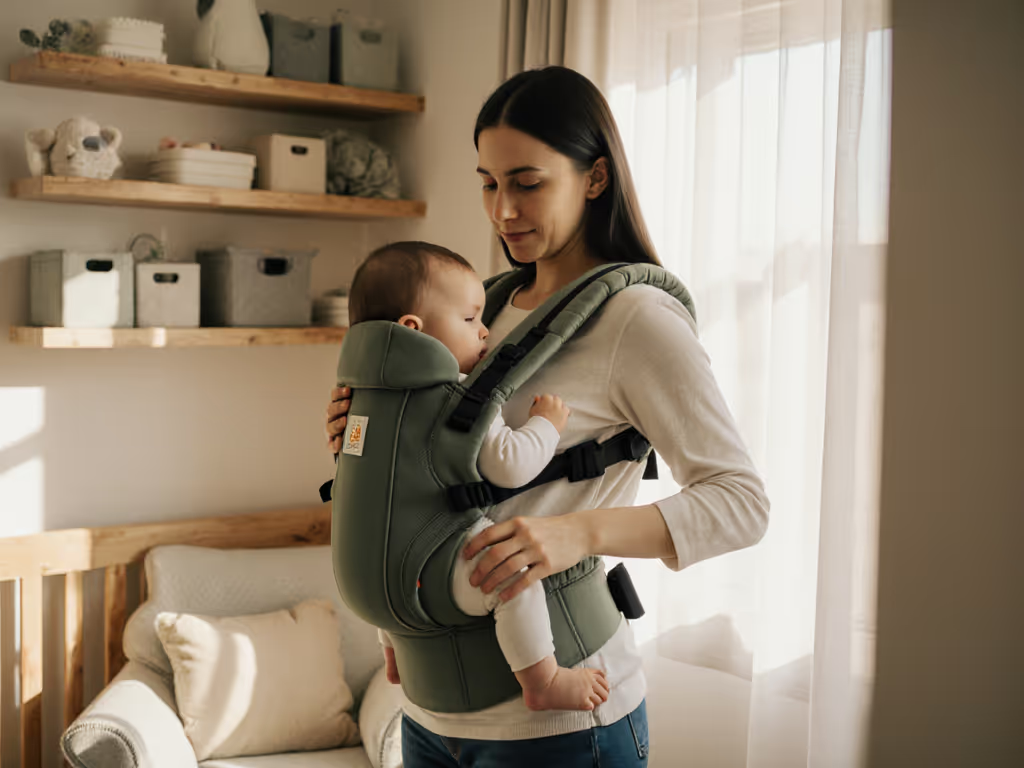
Complete Guide to Proper Baby Carrier Positions

Did you know that improper baby carrier use can increase the risk of hip dysplasia and breathing issues in infants? Many parents want to keep their little ones close, but safe babywearing requires more than comfort. Understanding the best carrier positions helps support healthy development and prevents serious injuries, giving both you and your baby peace of mind as you move through daily routines.
Key Takeaways
| Point | Details |
|---|---|
| Proper Positioning is Essential | Follow the TICKS rule to ensure safety and support baby’s development during carrier use. |
| Age-Appropriate Carrying | Choose carrier positions based on your baby's developmental stage to maximize support and comfort. |
| Prioritize Safety | Regularly inspect carriers and monitor baby's positioning and breathing to prevent potential risks. |
| Avoid Common Mistakes | Be aware of frequent pitfalls, such as C-shape positioning and incompatible carrier types, to keep your baby safe. |
Defining Proper Baby Carrier Positions
Every caregiver's ultimate goal is keeping their baby safe and comfortable while carrying them - and that starts with understanding proper baby carrier positioning. Getting positioning right isn't just about convenience; it's about ensuring your infant's physical safety and supporting their delicate developmental needs.
The international safety standard for baby carrier positioning is summarized by the memorable TICKS rule, which provides a comprehensive framework for safe babywearing:
- Tight: The carrier should fit snugly against your body with no loose fabric
- In view: Always keep baby's face visible and uncovered
- Close enough to kiss: Position baby high enough on your torso that you could easily kiss their head
- Keep chin off chest: Ensure baby's airway remains open and uncompressed
- Supported back: Maintain a natural, slightly curved spine position
Health authorities like Health Canada emphasize that for young infants, an inward-facing orientation is crucial.
 This positioning provides maximum neck and spinal support during the most vulnerable early months. The carrier should distribute your baby's weight evenly, preventing strain on their developing musculoskeletal system.
This positioning provides maximum neck and spinal support during the most vulnerable early months. The carrier should distribute your baby's weight evenly, preventing strain on their developing musculoskeletal system.
Remember: proper positioning isn't just a recommendation - it's a critical safety practice that protects your baby's breathing, supports healthy physical development, and ensures a comfortable experience for both caregiver and child.
Types of Baby Carrier Positions Explained
Navigating the world of baby carrier positions can feel overwhelming, but understanding the different options helps you choose the most comfortable and safe method for you and your little one. Each baby carrier position offers unique benefits and is suitable for different stages of your child's development.
Primary Baby Carrier Positions
The most common baby carrier positions include:
Here's a comparison of the primary baby carrier positions:
| Position | Best For | Key Benefits | Age/Stage Recommendations |
|---|---|---|---|
| Front Carry | Newborns<br>Younger infants | Close contact<br>Easy monitoring | 0-4 months<br>Weak necks |
| Hip Carry | Older infants | Greater mobility<br>Hip support | 6+ months<br>Good neck control |
| Back Carry | Toddlers | Even weight<br>Caregiver freedom | 9+ months<br>Sits independently |
| Kangaroo Carry | Young babies | Natural holding<br>Spine support | Birth to 3 months<br>Small infants |
- Front Carry: Ideal for newborns and younger infants, allowing close monitoring and direct interaction
- Hip Carry: Perfect for older babies with more neck control, providing easier movement for the caregiver
- Back Carry: Recommended for older infants and toddlers who can sit independently
- Kangaroo Carry: A vertical position that mimics natural holding and supports baby's spine
Pro Tip: For the first six months, prioritize the spread-squat or M-position, where baby's thighs are spread and knees are positioned higher than their bottom, which promotes healthy hip development.
Safety experts strongly recommend avoiding the traditional cradle hold in carriers, as it can compromise your baby's airway and does not provide adequate spinal support. When selecting a position, always consider your baby's age, neck strength, and developmental stage.

Remember that each carrier position requires careful adjustment to maintain the TICKS rule: ensuring the carrier is tight, baby is in view, close enough to kiss, chin is off the chest, and back is fully supported. Mastering these positions takes practice, so be patient with yourself as you learn what works best for you and your baby.
Age-Appropriate Positioning and Ergonomic Support
Your baby's physical development is a delicate journey, and carrier positioning plays a crucial role in supporting their growth. Each stage of infancy requires a thoughtful approach to ensure both comfort and healthy musculoskeletal development.
Newborn to 4 Months: Delicate Support Phase
During the first few months, your baby needs maximum support and protection:
- Inward-facing carries are essential
- Full head and neck support is critical
- Frog-leg or M-position positioning prevents hip dysplasia
- Limit carrier use to approximately one hour to prevent strain
Critical Insight: Babies cannot support their own head until around 4 months, so complete neck and head support is non-negotiable.
As your baby grows, carrier positioning evolves. Around 5-6 months, when neck muscles strengthen, you can gradually introduce more varied positions. Outward-facing carries become possible, but should be used sparingly and only when your baby demonstrates consistent head and neck control.
Ergonomic support isn't just about comfort - it's about preventing potential developmental issues. Always prioritize carriers that allow natural hip and spine alignment, keeping your baby's legs spread wide and knees higher than their bottom. This positioning mimics the natural squatting position and supports healthy joint development during these critical early months.
Essential Safety Guidelines for Babywearing
Babywearing safety is about more than just comfort - it's about protecting your child's most vulnerable developmental stage. Understanding and implementing critical safety guidelines can prevent potential accidents and ensure your baby remains secure and supported throughout your carrying experience.
Key Safety Precautions
Safety experts recommend several fundamental guidelines for responsible babywearing:
- Always check carrier materials for wear and tear before each use
- Ensure the carrier provides proper head and neck support
- Verify that baby's airway remains clear and unobstructed
- Maintain visibility of baby's face at all times
- Avoid covering baby with additional clothing or coats that might compromise breathing
Critical Warning: Frameless slings pose significant risks for very young babies and should be avoided without professional guidance.
For babies under four months, extra caution is paramount. The TICKS rule remains your primary safety framework: Tight carrier, In view, Close enough to kiss, Keep chin off chest, and Supported back. This approach minimizes risks of positional asphyxia and ensures proper spine and hip alignment.
Remember that babywearing is a skill that requires continuous learning and adaptation. Regularly inspect your carrier, practice proper positioning, and never hesitate to seek professional advice if you're uncertain about technique or safety. Your vigilance directly contributes to your baby's protection and comfort.
Common Mistakes and How to Avoid Them
Babywearing seems intuitive, but numerous well-intentioned parents unknowingly make critical mistakes that can compromise their baby's safety. Awareness is your first line of defense in preventing potential risks during carrier use.
Top Babywearing Pitfalls
The most dangerous mistakes parents frequently encounter include:
- C-shape positioning that dangerously compresses the baby's airway
- Improper carrier sizing that fails to support proper hip development
- Attempting hands-free breastfeeding without proper supervision
- Using carriers that don't match the baby's current developmental stage
- Neglecting to monitor baby's breathing and positioning
Critical Warning: Avoid products marketed as "womb-like" or "cocoon" carriers, as these often encourage unsafe C-shape positioning that can obstruct breathing.
Product safety experts emphasize that carrier selection is not one-size-fits-all. Each carrier must be precisely matched to your baby's current size, weight, and developmental milestone. What works for a two-month-old will not be appropriate for a six-month-old infant. This means regularly reassessing your carrier's fit and being willing to adjust or replace it as your baby grows.
Remember that constant vigilance is key. No carrier is completely foolproof, and no single position works in all circumstances. Always stay alert, frequently check your baby's positioning, and trust your parental instincts if something doesn't feel right.
Take the Stress Out of Babywearing: Find Your Perfect Carrier Solution
If you feel overwhelmed by the risks and complex rules of proper baby carrier positions, you are not alone. Many parents struggle with making sure their baby's back and hips are truly supported, especially as they try to master complicated concepts like the TICKS rule and ergonomic positioning. You want the confidence that comes from knowing you are giving your infant the safest start during every moment of babywearing.
At Caregiver Carry, we understand how important it is to get it right from the very first carry. Whether you need clear safety checklists, expert carrier reviews and comparisons, or step-by-step positioning guides, our evidence-based resource is here to help. Visit Caregiver Carry now and discover actionable tips and trusted product recommendations, so you can ensure every babywearing moment is both safe and comfortable. Do not wait to give your baby the secure start they deserve.
Frequently Asked Questions
What are the recommended positions for carrying a newborn in a baby carrier?
The best position for carrying a newborn is the Front Carry, which allows for close contact and easy monitoring of the baby. It's essential that the baby is inward-facing and receives full head and neck support.
How can I ensure my baby is positioned safely in a carrier?
To ensure safe positioning, follow the TICKS rule: the carrier should be Tight, the baby's face In view, positioned Close enough to kiss, with the chin off the chest, and providing a Supported back. This will help maintain proper airway and spinal alignment.
When can I start using outward-facing carries for my baby?
You can start introducing outward-facing carries when your baby shows consistent head and neck control, typically around 5-6 months. However, this should only be done occasionally and with careful monitoring.
What is the importance of ergonomic support in baby carriers?
Ergonomic support is crucial as it promotes healthy musculoskeletal development for your baby. Carriers should allow for natural hip and spine alignment, keeping the baby’s legs spread wide and knees higher than their bottom, which helps prevent conditions like hip dysplasia.



